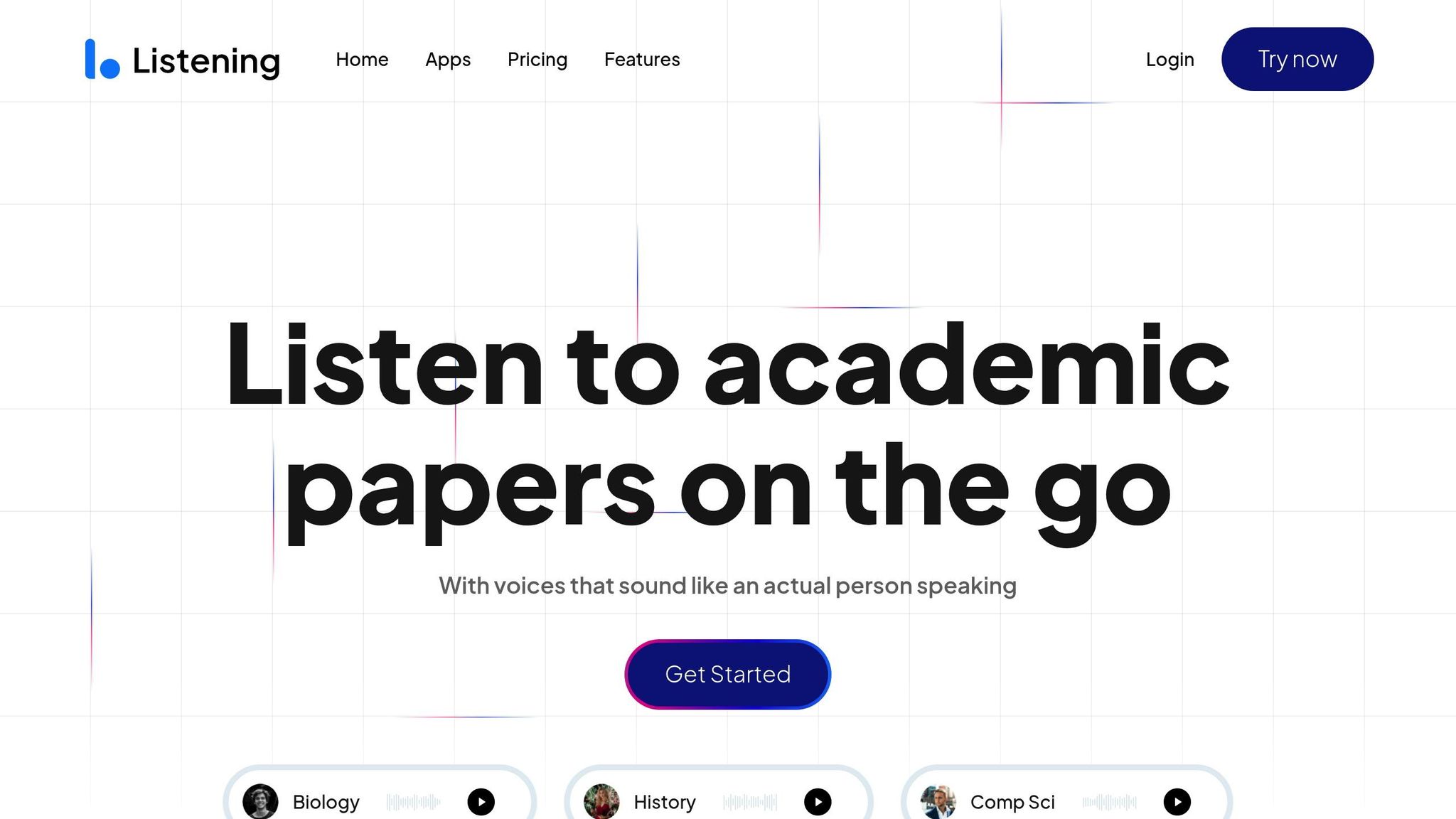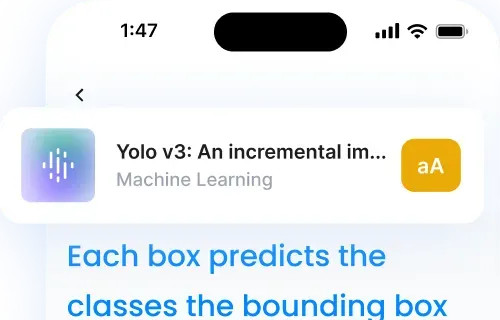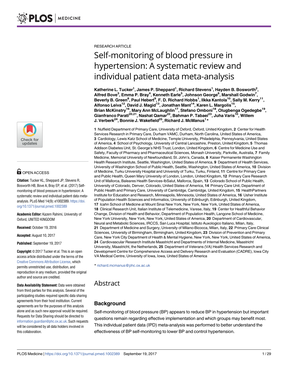Reducing screen time with text-to-speech as a student may not even feel like an option. We are so focused on deadlines, readings, papers, and online classes that screens become an unavoidable part of daily life. Even outside of academics, the cycle continues — social media apps are designed to capture our attention and keep us scrolling, while the easiest way to unwind after a long day of schoolwork is often zoning out in front of the TV.
The result? Our brains rarely get a true break from screens and we end up with eye strain while trying to study or complete our academic tasks. In addition to eye strain, this constant digital stimulation can lead to mental fatigue, poor sleep, and even increased anxiety. That’s why tools like text-to-speech (TTS) can be so powerful — they offer a way to stay engaged with schoolwork while giving your eyes (and your nervous system) a much-needed rest.
Whether you’re reading research papers, writing essays, or keeping up with coursework, screen fatigue is real. Text-to-speech (TTS) tools can reduce screen time for students by turning academic content into audio—helping you stay productive without straining your eyes.
Key Takeaways:
- Understand how to reduce screen time with text-to-speech by converting academic content into audio
- Recognize the impact of excessive screen time on student health, including eye strain, fatigue, and burnout
- Explain how text-to-speech supports screen-free study habits and improves overall learning balance
- Identify essential text-to-speech features that help students reduce screen time, such as citation skipping, natural voices, and section-specific listening
- Apply practical strategies to integrate text-to-speech into your daily routine, including multitasking and mobile learning
- Evaluate how audio-based learning improves focus, retention, and productivity while minimizing screen exposure
- Take action to create a healthier, more sustainable study routine by using text-to-speech to reduce screen time
What Do We Mean By “Reduce Screen Time With Text-to-Speech”?
Reducing screen time doesn’t mean avoiding technology altogether—it means being more intentional about how and when we use it. For students, this often looks like finding alternatives to staring at a screen for every task, especially when studying or reviewing material. Instead of reading every article, assignment, or email visually, tools like text-to-speech allow you to absorb information through audio, giving your eyes a break while keeping your mind engaged. Reducing screen time is about creating balance—protecting your vision, improving focus, and preventing burnout by shifting some of your digital habits in smarter, healthier ways.
Reduce Screen Time with Text-to-Speech: Why It Matters for Students
For students today, reducing screen time can feel nearly impossible. Assignments, online classes, research, and group chats all demand hours in front of a screen. And when the academic day ends, it’s easy to fall into the trap of endless scrolling on social media or binge-watching TV—activities that seem relaxing but keep our eyes and brains locked into screens even longer.
This constant exposure isn’t just tiring—it can take a real toll on your mental and physical well-being. Eye strain, headaches, disrupted sleep, and mental fatigue are common side effects of excessive screen time. Over time, the lack of screen-free moments can also increase anxiety and make it harder to focus when it really matters.
That’s where text-to-speech (TTS) comes in. Instead of staring at your laptop to get through another dense reading or research paper, TTS lets you convert that content into audio. You can listen while walking, cooking, commuting, or just closing your eyes for a moment. It creates built-in screen breaks without interrupting your academic momentum.
Whether you’re trying to stay on top of coursework, review readings, or process dense material, TTS gives your eyes a break while keeping your brain engaged. It’s a simple, science-backed way to reduce screen time for students—without sacrificing productivity.
How to Reduce Screen Time With Text-to-Speech
Text-to-Speech Basics
Text-to-speech (TTS) technology converts written text into spoken audio, helping reduce the amount of time spent staring at a screen. Modern TTS tools use advanced AI to create audio that sounds natural and engaging. For instance, Listening (https://listening.com) turns academic texts into audio, making it easier for researchers and students to access information without being glued to their screens.
This technology can read aloud PDFs, research papers, and other documents in clear, natural-sounding speech. It handles complex academic language with ease and works across multiple formats, including web pages and emails. By reducing the need for prolonged screen time, TTS opens the door to more productive and focused audio-based learning.
Additional Advantages Beyond Reduced Screen Time
Audio learning doesn’t just give your eyes a break – it also turns downtime into opportunities for learning and helps boost focus. Here’s how audio learning benefits both eye health and productivity:
| Benefit | Impact on Eye Health | Productivity Boost |
|---|---|---|
| Reduce Screen Time | Cuts down on screen exposure | Lets you learn while resting your eyes |
| Multitasking | Allows listening during activities | Makes use of idle moments for studying |
| Better Focus | Eliminates visual distractions | Helps improve information retention |
| Flexible Learning | Works in any lighting condition | Makes studying possible in tricky scenarios |
Studies show that people forget about 70% of what they read within 24 hours if they don’t take notes. TTS tools help tackle this issue by letting users jot down key points while listening.
One academic user shared:
“This works surprisingly well – minimalistic app but the magic is in the background. Share PDFs to it and listen while taking a walk! Ideal for me.”
Another user highlighted its practicality:
“Perfect for converting large texts into audio… It became significantly faster, easier, and clearer to absorb textbooks.” – Meloman F.
Reduce Screen Time with Computer-based Text-to-Speech
Features of Reduced Screen time with Text-to-Speech for Academics
Text-to-speech (TTS) tools can make academic work more efficient while helping reduce eye strain. These features not only simplify research but also improve the overall user experience.
Voice Quality and Speed Controls
High-quality, natural-sounding voices with adjustable speed settings are essential for comfortable listening and better understanding.
“Great way to listen to papers during my commute. Finally, a voice that doesn’t sound like a robot.” – Tim Osterbuhr
Accurate pronunciation is equally important, especially for technical or scientific terms. As one user shared:
“Absolutely brilliant, haven’t been able to find an app that can say scientific words properly until now. Very easy to use.” – Samantha Lumby
These features make listening to complex academic texts more practical and enjoyable.
Academic Document Support
TTS tools designed for academic use often include features tailored to specific needs. These capabilities enhance the listening experience and help users focus on the content:
| Feature | How It Helps Reduce Eye Strain |
|---|---|
| Citation Skipping | Removes references to maintain smooth flow |
| Section Selection | Lets users focus on specific parts of the text |
| Format Support | Works with PDFs, Word documents, EPUB, and more |
“Brilliant app! My favorite part is that you can turn off citations so the text reads smoothly, and you can easily skip unimportant information.” – Róisín Hennessy
These options ensure that academic texts are easy to navigate and listen to.
Device Support and Simple Interface
Ease of use across devices is crucial for academics on the go. A straightforward interface combined with device compatibility enhances productivity.
“Amazing! This is my new favorite app! Uploading PDFs is so easy on the phone, and the narration sounds very natural! Perfect for listening to academic papers (or any other texts) – so convenient and saves so much time!” – Baobei de Bei
With multi-device access, quick note-taking, and intuitive navigation, TTS tools simplify workflows and reduce the need for prolonged screen time.
Reduce Screen Time By Adding Text-to-Speech to Your Study Routine
Reduce Screen Time With Listening

Text-to-speech tools make it easier to reduce screen time and also take notes by listening without breaking your focus. With features like one-click note-taking, you can quickly capture key points. These notes are automatically timestamped and synced across devices, saving you from flipping through multiple notebooks or files.
Studies indicate that 70% of what we read is forgotten within 24 hours unless notes are taken. Here’s how text-to-speech can help you retain more with less screen time:
| Note-Taking Strategy | How It Helps Reduce Eye Strain |
|---|---|
| One-Click Capture | Instantly saves the last two sentences without needing to type |
| Auto-Timestamping | Lets you quickly find specific sections without re-reading |
| Cross-Device Sync | Access your notes anywhere while cutting down on screen time |
| Parallel Reading | Includes optional visual cues to improve understanding |
Balancing Screen Time and Listening
Using text-to-speech can also help you reduce screen time by substituting reading with listening during certain parts of your day. This approach not only prevents eye strain but also creates a more balanced routine.
| Time of Day | Activity | How It Reduces Eye Strain |
|---|---|---|
| Morning Commute | Listen to research papers | Start your day with audio instead of screens |
| Lunch Break | Review notes quickly | Take short screen breaks (e.g., follow the 20-20-20 rule) |
| Afternoon Exercise | Process academic material | Give your eyes a complete rest from screens |
| Evening Routine | Listen while cooking | Avoid blue light exposure before bedtime |
To make the most of this approach, focus on specific sections of papers and adjust playback speed (up to 3x) based on your comprehension level. This way, you can stay productive without overwhelming your eyes.
Conclusion: Reduce Screen Time with Text-to-Speech
Text-to-speech (TTS) technology offers a practical solution for students looking to reduce screen time without falling behind. By converting academic content into audio, TTS allows you to step away from your screen while still staying engaged with your studies. Whether you’re listening during your commute, while exercising, or as part of your evening routine, TTS helps you protect your eyes, prevent burnout, and build a more balanced, sustainable approach to learning. By reducing screen time, TTS supports a healthier and more sustainable study routine.
Users have shared positive experiences with TTS tools. For example, Joseph Waters shared:
“I tried a lot of text-to-speech apps before finding listening. From the purpose of reading academic books or papers it takes the top spot. It reliably skips footnotes and other content I do not want read out, and this cannot be said for other apps. I’m impressed.”
| Feature | Eye Health Impact | Productivity Boost |
|---|---|---|
| Natural Voice Quality | Lowers reliance on screens | Keeps focus on the material |
| Section-Specific Listening | Cuts down on unnecessary reading | Highlights only relevant details |
| Mobile Accessibility | Promotes screen-free learning | Turns downtime into study time |
| Smart Citation Handling | Reduces visual fatigue | Simplifies understanding |
Using text-to-speech is a practical way to care for your eyes while staying academically productive.
FAQs
How can text-to-speech technology help reduce screen time for students?
Text-to-speech (TTS) technology helps reduce screen time for students by converting textbooks, articles, research papers, and even emails into audio. Instead of reading everything on a screen, students can listen while walking, commuting, or resting their eyes. This approach lowers visual fatigue while keeping study habits consistent and productive.
By using tools like the Listening app, you can enjoy features such as human-like voice synthesis, the ability to skip less relevant sections like citations, and the convenience of listening on the go. This not only reduces the strain on your eyes but also helps you stay productive wherever you are.
What are the best features in a TTS tool to help students reduce screen time?
To reduce screen time effectively, students should look for TTS tools with natural-sounding voices, adjustable playback speeds, and features like citation skipping and section selection. Tools like Listening also offer one-click note-taking and multi-device sync, allowing students to stay organized and focused without being glued to their screens.
Can text-to-speech tools really improve productivity while reducing screen time?
Yes! By turning passive screen time into active listening, students can multitask and study more efficiently. TTS tools help reduce screen time for students by allowing them to absorb content during daily routines like commuting, exercising, or doing chores—all while staying on track with their academic goals. By converting text into audio, they let you listen to documents, research papers, emails, or websites instead of staring at a screen for long periods. This not only gives your eyes a break but also allows you to multitask, like listening while commuting or exercising.
How do I start using TTS to reduce screen time in my study routine?
To get started, try using a tool like Listening, an AI-powered app that offers features such as human-like voice synthesis, skipping citations, and section-specific playback. You can upload files directly, use a browser extension for websites, or even forward emails to convert them into audio. The app works seamlessly across iOS, Android, Chrome, and web platforms, making it easy to integrate into your daily routine.









